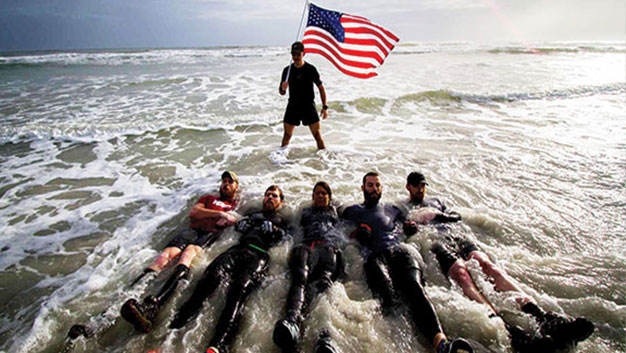For many people, the term “adventure team building” is likely to conjure up images of physically demanding activities in a wild, outdoor setting. That image is sometimes quite accurate. Take this over-the-top but true example involving a group of mostly young coworkers from a West Coast consulting firm.
Starting the day in a mountainside town, they:
- got a list of clues to locate keys to two SUVs
- found instructions in the SUVs to navigate a rock-and-dirt road up the mountain
- saw a sign directing them to kayaks on the shore of a fast-moving stream; inside was a GPS unit and clues to find various parts of fishing rods hidden downstream
- paddled to calmer waters and found the parts; then new instructions had them assemble the rods and catch two fish
- were directed to ride mountain bikes three miles to an overlook, where event facilitators welcomed them with a steak barbecue
On the flip side, most people don’t know that when it comes to team-building activities, what qualifies as “adventure” is actually in the eye of beholder. “Adventure is definitely a relative term for each group we work with,” says Will Leggett, vice president of Jackson, Wyoming-based Grand Dynamics. “Sure, we have a few groups that want to be dropped into the woods to camp overnight and make their way out using GPS units. But if we’re working with a team of middle-aged managers, we’ll do something that’s exciting for them but not too risky: a road-biking challenge, flat-terrain mountain biking on wooded trails, or a flat-water kayak or canoe trip.”
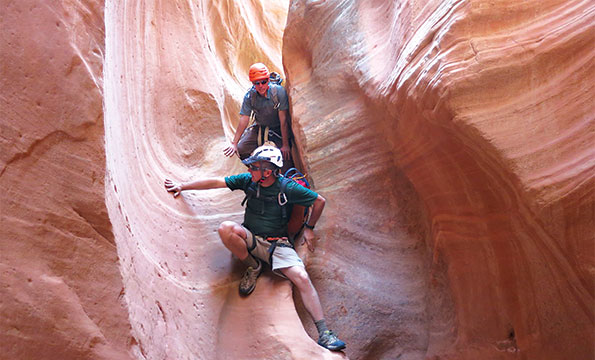
Finding the way with Grand Dynamics, based in Jackson, Wyoming
Lisa Howard, trainer and staffing coordinator for Project Adventure in Beverly, Massachusetts, a firm that offers low- and high-ropes courses among its activities, adds that “adventure is simply a methodology, a way of working with groups that will bring about their goals through physical means.”
Team building at Project Adventure can range from exercises that are active but not strenuous—such as timed problem-solving initiatives that require moving around various materials and props—to scaling the top of the company’s challenge course. On the course, activities include blindfolded participants being guided by colleagues to step over or slip through obstacles; short climbs on low ropes where participants assist and protect one another; and rock-climbing-style belaying (with wired safety harnesses) as participants help each other move high above the ground.
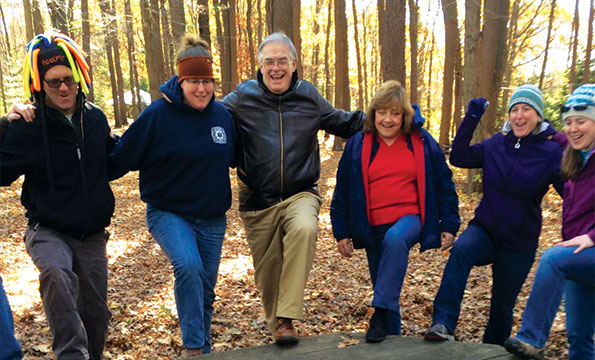
Group problem-solving at Project Adventure, Beverly, Massachusetts
Why It Works—and Ensuring That It Does
Meeting groups that use adventure team building have a variety of goals they seek to fulfill. Some groups are simply looking to decompress from the rigorous focus required in meeting sessions, and opt for a few hours of active fun so participants go home with a good memory of being together. Other groups, though, have objectives more closely related to the business issues being addressed in their meetings; this can require several hours of team building, plus post-activity debriefing.
Among the most common objectives is improving problem-solving, enhancing communication and boosting process efficiency or time management. Others are even larger in scope, especially when an organization is in flux: Merging different divisions or companies into a single culture, adapting to changes that come from downsizing and crafting a new mission statement are all tasks in which team-building activities frequently play a role.
“The goal is to have a shared experience that is condensed and dramatic,” says Lain Hensley, co-owner of Odyssey Teams, a Chico, California-based firm that uses trees, poles, ropes, harnesses and other items to execute many of its sessions. “Business can have its drama over six months or a year, but adventure team building brings that intensity in a very short time frame, and ensures that everyone experiences it together. People get to see qualities in each other they don’t see in the business environment, which brings better understanding of each other and new respect.”
Both Howard and Leggett call adventure team building “the great leveler” among groups that have a range of ages, titles and work experience. “No matter if you’re the CEO or a new front-line hire, the playing field is even when doing these activities,” Leggett notes. “It takes everyone out of their area of expertise and their comfort zone, and nobody knows what is expected of them. So they have to discover each other’s strengths and use them to succeed in the challenge.”
For any objective, a team-building provider will work with a meeting planner ahead of an event to understand the business issues the group faces and the dynamic between participants. “We want to understand the language the group uses so we can mirror that language and their concepts in the activities we create,” Leggett says.
Hensley adds, “Our value comes from bringing out the content and conversations they’re having in the meeting room. The more we can reflect situations they have at work in an activity that’s disconnected from their work, the better chance we have to produce that ‘Aha!’ moment.”
Action and Reaction
Last summer, Grand Dynamics worked with a local hospital that had recently enacted job cuts. A department of 15 nurses was brought to the Teton Mountains outside Jackson, Wyoming, to participate in an adventure team-building activity. The purpose was to rebuild their morale and help them figure out how to reconfigure their working environment—and their relationship with one another—to handle the increased workload.
Leggett met with the meeting planner ahead of time to discuss the situation, the objectives and the general physical profile of the participants. Then the agenda was set: The one-day program would focus on building effective communication and proving the value of mutual support.
At the foot of the mountain the nurses were split into two groups, each with a two-way radio. One group hiked to a clearing that had a fully constructed campsite containing several tents and a stone fire pit. The other group hiked to a clearing that had the same items, but none of them constructed. The task: One group had to explain via radio to the other group how to construct the campsite.
“It was a great way to get them to listen to each other really closely, and learn how to communicate clearly in both directions,” Leggett says. The team eventually succeeded, and during the lunch break each half of the team shared its best practices on how they assigned various duties and sequenced their actions for maximum efficiency.
No matter the level of success a group has in its adventure activity, some type of debriefing session should take place afterward so that what was learned can be applied to the workplace environment.
“Groups get the full value of the experience when they compare their norms at work to the new approaches they used in the activities, and understand how they can create a new norm at the office because they see it works,” Howard says.
A debrief with an experienced provider helps facilitate the conversation “in a way that addresses the structural and behavioral issues at work, but does it in a non-threatening way,” Howard says. To maximize effectiveness, meeting planners and facilitators should partner well before the event to figure out the issues to cover, desired results and specific takeaways.
Summing Up
Adventure team building found its footing in the business world in the mid-1980s, and has proven its value as a tool for improvement. The proof: Most team-building firms have a repeat-client rate above 50 percent. With typical costs for a facilitator-led adventure team-building program at roughly $3,000 per day plus travel expenses to the meeting destination, it’s clear that many business groups recognize the benefit gained from having their people hike, bike, climb, paddle or engage in some other adventure on their path to success.
To the Max
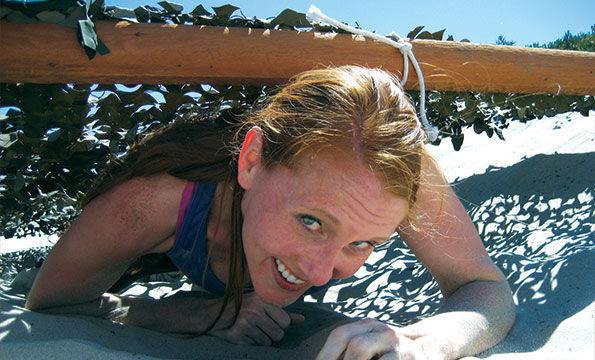
Navy Seal Boot Camp, Loews Coronado Bay Resort, San Diego
Does your group want a taste of Navy Seal training maneuvers? Would your team revel in sessions led by former special operations and intelligence specialists?
Some groups want an adventure team-building experience that pushes them to the max, physically and mentally. A few companies offer just that, touting their sessions’ ability to foster teamwork through intense, almost military-style exercises.
For example, Loews Coronado Bay Resort in San Diego offers a Navy Seal Boot Camp for groups from 20 to 350, taught by former Seals. Sessions generally last a few hours, and activities, which take place on the beach, simulate what Seals go through during their notorious Hell Week (a grueling training operation that separates Seals from the rest of us). These can include calisthenics (including team sit-ups using a heavy wooden pole), obstacle courses and team challenges.
Goruck, headquartered in Jacksonville Beach, Florida, builds and sells rucksacks and other outdoor gear, and leads team-building endurance events based on staff facilitators’ experiences in special forces. Founder Jason McCarthy is a former Green Beret who started the events to test the gear, but now focuses his company on people and “building better Americans.”
Goruck’s events range from half-day, 7–10 mile introductory sessions with weighted rucksacks to multiday survival courses (the latter have names such as Amphibious Operations, and Urban Escape and Evasion). Its Corporate Solutions are customized sessions for groups that can be physical or not, and, according to its site, involve “Spec Ops training, planning and execution in a corporate setting and military skills applicable to groups and businesses.”
Those who are not in Seal-shape, of course, will be happy that these outfits tailor their offerings to the individual group and its capabilities.
To the Max
Does your group want a taste of Navy Seal training maneuvers? Would your team revel in sessions led by former special operations and intelligence specialists?
Some groups want an adventure team-building experience that pushes them to the max, physically and mentally. A few companies offer just that, touting their sessions’ ability to foster teamwork through intense, almost military-style exercises.
For example, Loews Coronado Bay Resort in San Diego offers a Navy Seal Boot Camp for groups from 20 to 350, taught by former Seals. Sessions generally last a few hours, and activities, which take place on the beach, simulate what Seals go through during their notorious Hell Week (a grueling training operation that separates Seals from the rest of us). These can include calisthenics (including team sit-ups using a heavy wooden pole), obstacle courses and team challenges.
Goruck, headquartered in Jacksonville Beach, Florida, builds and sells rucksacks and other outdoor gear, and leads team-building endurance events based on staff facilitators’ experiences in special forces. Founder Jason McCarthy is a former Green Beret who started the events to test the gear, but now focuses his company on people and “building better Americans.”
Goruck’s events range from half-day, 7–10 mile introductory sessions with weighted rucksacks to multiday survival courses (the latter have names such as Amphibious Operations, and Urban Escape and Evasion). Its Corporate Solutions are customized sessions for groups that can be physical or not, and, according to its site, involve “Spec Ops training, planning and execution in a corporate setting and military skills applicable to groups and businesses.”
Those who are not in Seal-shape, of course, will be happy that these outfits tailor their offerings to the individual group and its capabilities.
Adventure Team-Building Resources: A Sampling
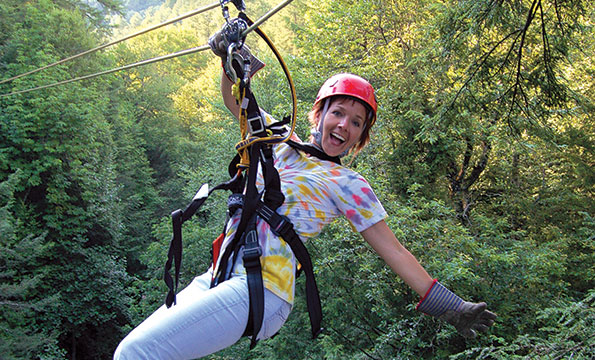
Ziplining at Skamania Lodge, A Destination Hotel, Stevenson, Washington
Workshops include orienteering, where participants explore forest preserves and state parks in the United States while learning topographical map reading, compass reading and distance pacing. Each team member takes on a distinct role and works with other members to achieve a common goal. Trainers are located in every state.
The survival program breaks a group into tribes that go head-to-head. Tribe leaders are given the day’s agenda and a team banner; each tribe creates their name and a chant for the tribal council. Other activities include wilderness scavenger hunts using off-road vehicles or snowmobiles. Headquarters is in Aurora, Colorado. Trainers will travel throughout Colorado.
Among the offerings: Team Adrenaline Rush, a series of high-intensity activities that can include bikes, kayaks, foot navigation, public transportation, swimming and climbing walls. The overall objective is not speed, but instead strategy and effective execution. Headquarters, with challenge course, is in Golden, Colorado, but trainers are located throughout the country.
Located on several thousand acres east of Scottsdale, Arizona, and adjacent to We-Ko-Pa Resort & Conference Center; offers GPS-guided hiking, river kayaking, horseback-led cattle drives, desert Jeep races and more.
Works with groups meeting in Washington, D.C., Maryland and Virginia. One program teaches wilderness survival skills such as finding/collecting water, fire-building and shelter-building as groups hike the back country of Catoctin Mountain Park. Other activities include rock climbing, caving and mountain biking challenges, and ropes courses.
Headquarters is in Jackson, Wyoming. Features “All Mountain Challenge,” “Amazing Race” and GPS treasure hunts, among other programs. Trainers are located throughout the country; company also partners with selected resorts.
Secluded island property 30 minutes outside Charleston, South Carolina. Activities include bicycle scavenger hunts with physical challenges at each stop, as well as races and oyster-collecting contests via canoe, followed by an oyster roast.
Conference facility for 80 attendees along the Sheboygan River in Kohler, Wisconsin. Offers low and high ropes courses, sailing races, GPS-guided scavenger hunts and food-prep and cooking competitions.
Heavily wooded property located 90 minutes outside Pittsburgh. Activities include combat paintball, sled building and racing, white-water rafting and a ropes course.
Headquarters with challenge course is in Chico, California. Also conducts philanthropic and youth team-building programs. Trainers will travel to meeting facilities nationwide.
Park City Marriott and Whiteface Lodge
Set in Lake Placid, New York, and Park City, Utah—former sites of the Olympic Games and present sites of U.S. Olympic training facilities—these properties offer Olympic-themed team events and competitions plus horseback riding, white-water rafting, GPS-guided scavenger hunts and mountain hiking. Team-building trainers are available, as are Olympic athletes.
Programs include white-water canoeing and rafting as well as survival simulations and team sailing. Trainers will travel to meeting facilities nationwide.
Headquarters, with challenge course plus conference facility, is in Beverly, Massachusetts. Trainers will travel to meeting facilities nationwide, and challenge courses are designed to suit your needs.
Skamania Lodge, A Destination Hotel
The lodge offers a professionally guided, 2 1/2-hour zipline tour, with seven different lines, ranging from 100 to 900 feet, and three sky bridges. It takes place outside Portland, Oregon, in the heart of the Columbia River Gorge. Team members cheer each other on while soaring through an old growth forest with views of the Columbia River.
